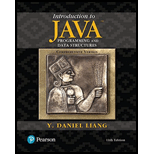
Introduction to Java Programming and Data Structures, Comprehensive Version (11th Edition)
11th Edition
ISBN: 9780134670942
Author: Y. Daniel Liang
Publisher: PEARSON
expand_more
expand_more
format_list_bulleted
Question
Chapter 27.4, Problem 27.4.2CP
Program Plan Intro
Open Addressing:
- Open Addressing is a method of finding an open location in the hash table at the time of collision.
- There are several variations for open addressing such as linear probing, quadratic probing, and double hashing.
Linear Probing:
- Linear probing is one of the variations of open addressing.
- When an entry is inserted into a hash table, a collision occurs. At the time of collision, linear probing will start finding the next available location sequentially.
- Linear probing will look at the consecutive cells which begin at index k.
- Starting from the initial index, linear probing will add an increment of 1 to k to define a search sequence.
Expert Solution & Answer
Want to see the full answer?
Check out a sample textbook solution
Students have asked these similar questions
Write the SQL code that permits to implement the tables: Student and Transcript. NB: Add the constraints on the attributes – keys and other.
Draw an ERD that will involve the entity types: Professor, Student, Department and Course. Be sure to add relationship types, key attributes, attributes and multiplicity on the ERD.
Draw an ERD that represents a book in a library system. Be sure to add relationship types, key attributes, attributes and multiplicity on the ERD.
Chapter 27 Solutions
Introduction to Java Programming and Data Structures, Comprehensive Version (11th Edition)
Ch. 27.2 - Prob. 27.2.1CPCh. 27.3 - Prob. 27.3.1CPCh. 27.3 - Prob. 27.3.2CPCh. 27.3 - Prob. 27.3.3CPCh. 27.3 - Prob. 27.3.4CPCh. 27.3 - Prob. 27.3.5CPCh. 27.3 - Prob. 27.3.6CPCh. 27.3 - If N is an integer power of the power of 2, is N /...Ch. 27.3 - Prob. 27.3.8CPCh. 27.3 - Prob. 27.3.9CP
Ch. 27.4 - Prob. 27.4.1CPCh. 27.4 - Prob. 27.4.2CPCh. 27.4 - Prob. 27.4.3CPCh. 27.4 - Prob. 27.4.4CPCh. 27.4 - Prob. 27.4.5CPCh. 27.4 - Prob. 27.4.6CPCh. 27.5 - Prob. 27.5.1CPCh. 27.6 - Prob. 27.6.1CPCh. 27.6 - Prob. 27.6.2CPCh. 27.6 - Prob. 27.6.3CPCh. 27.7 - Prob. 27.7.1CPCh. 27.7 - What are the integers resulted from 32 1, 32 2,...Ch. 27.7 - Prob. 27.7.3CPCh. 27.7 - Describe how the put(key, value) method is...Ch. 27.7 - Prob. 27.7.5CPCh. 27.7 - Show the output of the following code:...Ch. 27.7 - If x is a negative int value, will x (N 1) be...Ch. 27.8 - Prob. 27.8.1CPCh. 27.8 - Prob. 27.8.2CPCh. 27.8 - Can lines 100103 in Listing 27.4 be removed?Ch. 27.8 - Prob. 27.8.4CPCh. 27 - Prob. 27.1PECh. 27 - Prob. 27.2PECh. 27 - (Modify MyHashMap with duplicate keys) Modify...Ch. 27 - Prob. 27.6PECh. 27 - Prob. 27.7PECh. 27 - Prob. 27.8PECh. 27 - Prob. 27.10PECh. 27 - Prob. 27.11PECh. 27 - (setToList) Write the following method that...Ch. 27 - (The Date class) Design a class named Date that...Ch. 27 - (The Point class) Design a class named Point that...
Knowledge Booster
Similar questions
- 2:21 m Ο 21% AlmaNet WE ARE HIRING Experienced Freshers Salesforce Platform Developer APPLY NOW SEND YOUR CV: Email: hr.almanet@gmail.com Contact: +91 6264643660 Visit: www.almanet.in Locations: India, USA, UK, Vietnam (Remote & Hybrid Options Available)arrow_forwardProvide a detailed explanation of the architecture on the diagramarrow_forwardhello please explain the architecture in the diagram below. thanks youarrow_forward
- Complete the JavaScript function addPixels () to calculate the sum of pixelAmount and the given element's cssProperty value, and return the new "px" value. Ex: If helloElem's width is 150px, then calling addPixels (hello Elem, "width", 50) should return 150px + 50px = "200px". SHOW EXPECTED HTML JavaScript 1 function addPixels (element, cssProperty, pixelAmount) { 2 3 /* Your solution goes here *1 4 } 5 6 const helloElem = document.querySelector("# helloMessage"); 7 const newVal = addPixels (helloElem, "width", 50); 8 helloElem.style.setProperty("width", newVal); [arrow_forwardSolve in MATLABarrow_forwardHello please look at the attached picture. I need an detailed explanation of the architecturearrow_forward
- Information Security Risk and Vulnerability Assessment 1- Which TCP/IP protocol is used to convert the IP address to the Mac address? Explain 2-What popular switch feature allows you to create communication boundaries between systems connected to the switch3- what types of vulnerability directly related to the programmer of the software?4- Who ensures the entity implements appropriate security controls to protect an asset? Please do not use AI and add refrencearrow_forwardFind the voltage V0 across the 4K resistor using the mesh method or nodal analysis. Note: I have already simulated it and the value it should give is -1.714Varrow_forwardResolver por superposicionarrow_forward
- Describe three (3) Multiplexing techniques common for fiber optic linksarrow_forwardCould you help me to know features of the following concepts: - commercial CA - memory integrity - WMI filterarrow_forwardBriefly describe the issues involved in using ATM technology in Local Area Networksarrow_forward
arrow_back_ios
SEE MORE QUESTIONS
arrow_forward_ios
Recommended textbooks for you
 Operations Research : Applications and AlgorithmsComputer ScienceISBN:9780534380588Author:Wayne L. WinstonPublisher:Brooks ColeNp Ms Office 365/Excel 2016 I NtermedComputer ScienceISBN:9781337508841Author:CareyPublisher:CengageCOMPREHENSIVE MICROSOFT OFFICE 365 EXCEComputer ScienceISBN:9780357392676Author:FREUND, StevenPublisher:CENGAGE L
Operations Research : Applications and AlgorithmsComputer ScienceISBN:9780534380588Author:Wayne L. WinstonPublisher:Brooks ColeNp Ms Office 365/Excel 2016 I NtermedComputer ScienceISBN:9781337508841Author:CareyPublisher:CengageCOMPREHENSIVE MICROSOFT OFFICE 365 EXCEComputer ScienceISBN:9780357392676Author:FREUND, StevenPublisher:CENGAGE L A Guide to SQLComputer ScienceISBN:9781111527273Author:Philip J. PrattPublisher:Course Technology Ptr
A Guide to SQLComputer ScienceISBN:9781111527273Author:Philip J. PrattPublisher:Course Technology Ptr

Operations Research : Applications and Algorithms
Computer Science
ISBN:9780534380588
Author:Wayne L. Winston
Publisher:Brooks Cole

Np Ms Office 365/Excel 2016 I Ntermed
Computer Science
ISBN:9781337508841
Author:Carey
Publisher:Cengage

COMPREHENSIVE MICROSOFT OFFICE 365 EXCE
Computer Science
ISBN:9780357392676
Author:FREUND, Steven
Publisher:CENGAGE L



A Guide to SQL
Computer Science
ISBN:9781111527273
Author:Philip J. Pratt
Publisher:Course Technology Ptr